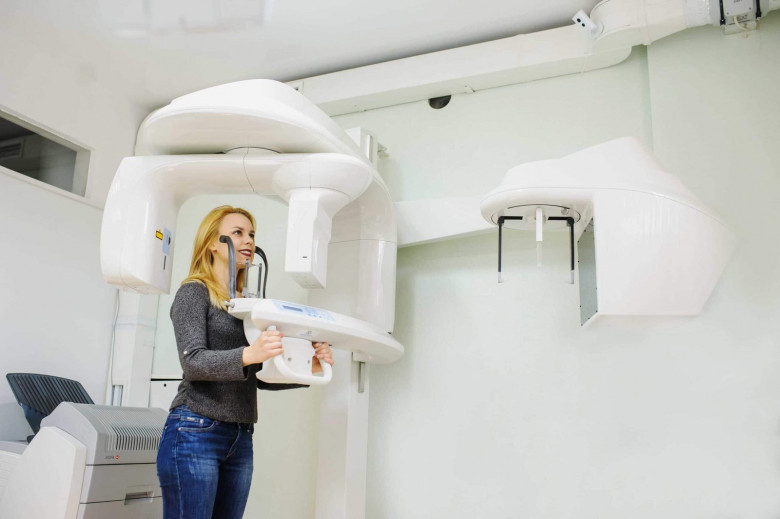views
Whether you’re visiting the dentist for routine care or preparing for oral surgery, you may be advised to undergo a Dental Panoramic X-Ray in Dubai. This imaging technique provides a broad view of your mouth, helping your dentist detect hidden conditions and plan treatments effectively. But is it necessary for everyone? Let’s explore what this technology offers and whether it’s the right choice for your specific dental needs.

What Is a Panoramic X-Ray:
A panoramic X-ray, or orthopantomogram (OPG), is a two-dimensional dental imaging method that captures your entire mouth in one image. Unlike bitewing or periapical X-rays that focus on small areas, panoramic X-rays offer a wide-angle overview of your teeth, jawbones, and surrounding structures.
-
Captures all teeth, upper and lower jaws, and TMJ
-
Includes sinuses and nasal area for broader diagnostics
-
Painless, quick, and non-invasive
When Dentists Typically Recommend It:
Not every patient requires a panoramic X-ray during routine dental visits, but it is highly recommended in specific scenarios. Your dentist will suggest it based on symptoms, procedures, or underlying concerns.
-
Prior to orthodontic or surgical procedures
-
For impacted or unerupted teeth
-
When investigating jaw pain or TMJ dysfunction
Ideal for Complex Diagnoses:
If your dental issue isn’t limited to a single tooth, a panoramic X-ray helps your dentist look at the bigger picture. It’s particularly useful for uncovering complex, underlying problems that can’t be seen during a physical exam.
-
Detects jaw cysts or tumors
-
Identifies bone loss from gum disease
-
Reveals fractured roots or jaw damage
Benefits for Orthodontic Patients:
Orthodontic planning relies heavily on understanding the position and growth of teeth. A panoramic X-ray is a critical tool in designing effective and safe orthodontic treatments.
-
Helps monitor tooth eruption in children and teens
-
Assesses space for incoming wisdom teeth
-
Tracks progress during treatment with braces or aligners
Evaluating Dental Implants and Surgery:
Before dental implants or other surgical procedures, panoramic X-rays provide essential information about bone health, nerve locations, and potential complications.
-
Confirms jawbone density for implants
-
Maps sinus and nerve positions
-
Prevents surgical surprises through pre-operative planning
Monitoring Jaw and TMJ Health:
If you experience discomfort in your jaw or hear clicking sounds when opening your mouth, a panoramic X-ray can help identify the source of these symptoms.
-
Highlights joint misalignment or wear
-
Detects signs of arthritis in the TMJ
-
Assists in diagnosing chronic jaw pain
Pediatric Dental Assessments:
Children and adolescents benefit greatly from panoramic imaging, especially when evaluating oral development or early intervention needs. It offers a clear look at growing jaw structures and developing teeth.
-
Identifies extra, missing, or unerupted teeth
-
Detects abnormalities in jaw growth
-
Aids in long-term treatment planning for bite correction
When It May Not Be Necessary:
While useful, a panoramic X-ray is not always needed for every dental visit. Your dentist will consider your symptoms, age, medical history, and risk factors before recommending it.
-
Not ideal for detecting small cavities
-
May be unnecessary for routine checkups without symptoms
-
Alternative imaging may be preferred for pregnant patients
Safety and Radiation Exposure:
Concerns about radiation are common, but modern digital panoramic X-rays are designed to minimize exposure. Dentists ensure the benefits of imaging always outweigh the minimal risks.
-
Radiation is lower than that of a typical day in natural sunlight
-
Digital systems further reduce exposure levels
-
Lead aprons and thyroid collars offer added protection
If you're receiving a Dental Panoramic X-Ray in Dubai, you can be confident that clinics follow stringent international safety standards.
Who Should Consider a Panoramic X-Ray:
You may be an ideal candidate for a panoramic X-ray if you're undergoing certain procedures or experiencing symptoms that require a comprehensive view of your mouth and jaw.
-
Patients preparing for braces, implants, or oral surgery
-
Individuals with unexplained dental or facial pain
-
Those with a history of periodontal disease or jaw trauma
What You’ll See in the Image:
Although it may look complex, your dentist will guide you through the key areas of your panoramic image. Understanding what’s visible helps you engage in your treatment plan more effectively.
-
Tooth alignment, root positions, and spacing
-
Jawbone structure and joint alignment
-
Possible cysts, abscesses, or unusual lesions
Advantages of Panoramic Imaging in Dubai:
Choosing to undergo a Dental Panoramic X-Ray in Dubai offers the added benefit of accessing the latest digital technologies and expert diagnostic care in world-class dental facilities.
-
Fast, accurate imaging with advanced equipment
-
Multilingual dental teams for personalized communication
-
Clinics equipped with cutting-edge diagnostic tools
Final Thoughts:
A panoramic X-ray is more than just a picture—it’s a powerful tool that helps your dentist understand the full landscape of your oral health. While it’s not needed for every patient or every visit, it becomes essential in cases that require surgical planning, orthodontic care, or complex diagnosis. If you're experiencing symptoms like jaw pain, suspect wisdom tooth issues, or preparing for a dental procedure, a panoramic X-ray might be exactly what you need. And with access to high-quality care, getting a Dental Panoramic X-Ray in Dubai ensures your treatment is supported by accuracy, expertise, and technology designed to keep you smiling.


Comments
0 comment